How Many People Should Suffer Before We TALK about it?
Human Rights’ movements tend to experience surges in popularity after emotionally intense, or traumatic, events. One such example is Black Lives Matter, which was founded in 2013 and was revived in 2020 after George Floyd’s death. Other benign (non-traumatic) events can also be catalysts for these movements: another example is the movie Bombshell, which was released in 2019 and reopened the conversation about workplace sexual harassment (#MeToo) that was first made famous in 2017.
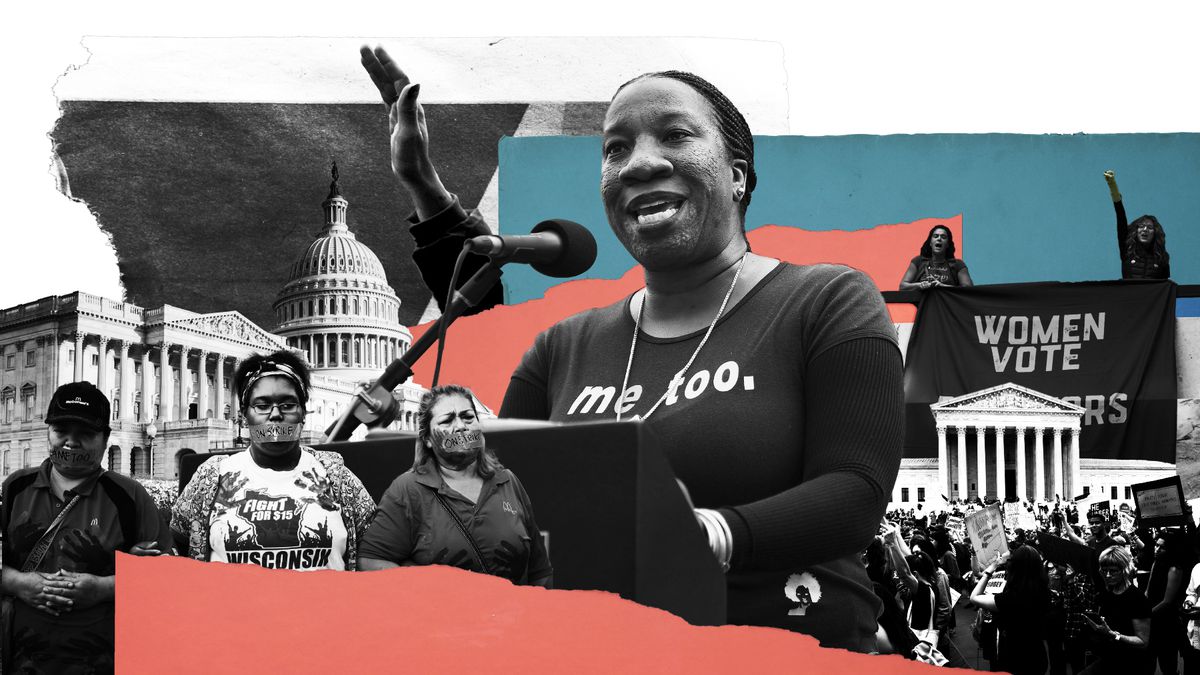 —
—
This data story focuses on the MeToo movement and in general about the topic of sexual harassment. We probe the media discourse and public opinion to gain insights about events and biases that characterize this discussion.
How to Tackle this Problem?
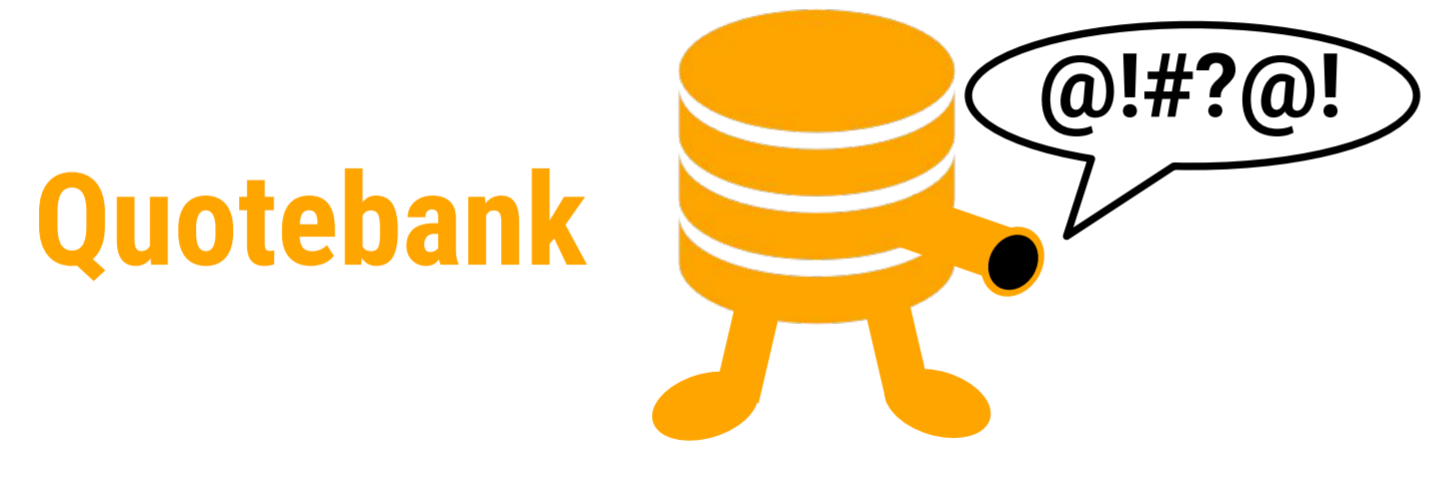 In order to explore the public perception of the MeToo movement and investigate the impact of traumatic/non-traumatic events we explore quotes in the Quotebank dataset from 2015 to 2020.
In order to explore the public perception of the MeToo movement and investigate the impact of traumatic/non-traumatic events we explore quotes in the Quotebank dataset from 2015 to 2020.
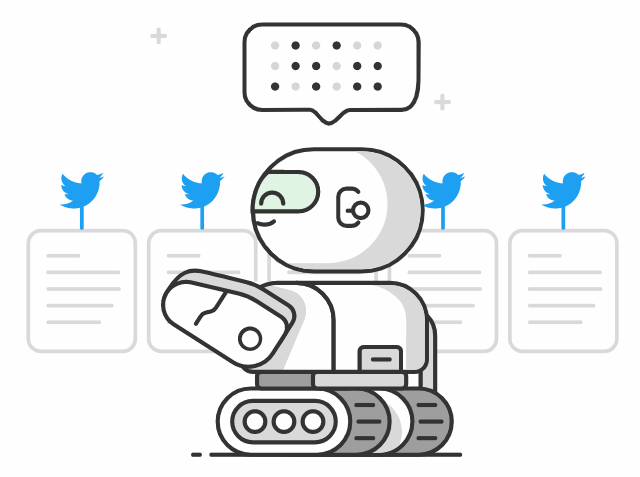 In order to augment our data, we have fetched tweets related to #MeToo from the public twitter API and integrated them with previously extracted tweets on MeToo.
In order to augment our data, we have fetched tweets related to #MeToo from the public twitter API and integrated them with previously extracted tweets on MeToo.
Research Questions
- Can we extract quotes related to the MeToo movement or Sexual Harassment in the workplace from Quotebank 2015-2020?
- What is the impact of the traumatic vs non-traumatic events on the MeToo movement, based on quotes and tweets involved in #MeToo?
- Is there a gender bias in the speakers of quotes related to sexual harassment?
- Can we observe cancel culture as a ramification of the #MeToo movement?
Can we extract quotes related to the MeToo movement or Sexual Harassment in the workplace from Quotebank 2015-2020?
We investigated the quotes in Quotebank throughout the years from 2015 to 2020 and we found a total of 115,584,251 quotes.
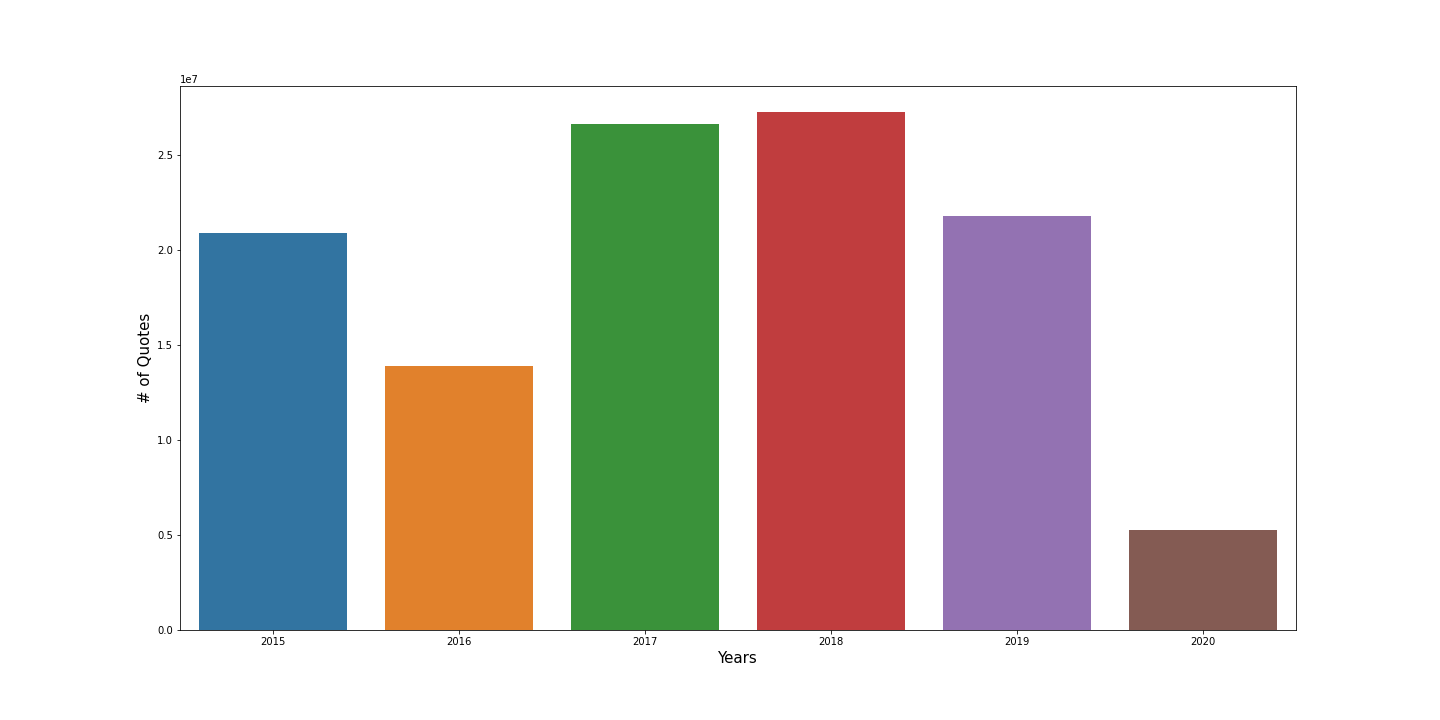
From these quotes, we extracted the words most frequently co-occurring with MeToo, shown in the word cloud below. We validated our results with a word cloud from a MeToo search on Media Cloud, a news-gathering website, to confirm that our sample is representative of the movement.
| Our Quotes 😎 | Media Cloud 📹 |
|---|---|
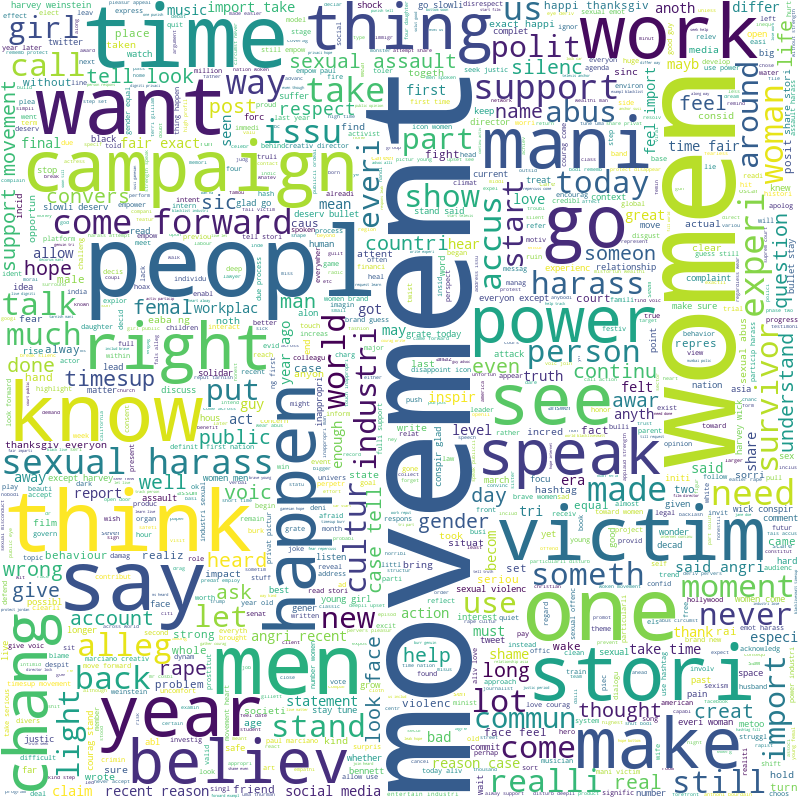 |
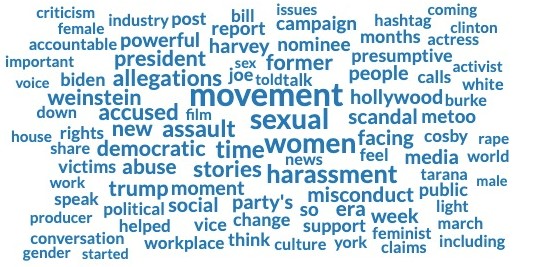 |
We then extracted from Quotebank2015-2020 the quotes including the keywords listed below :
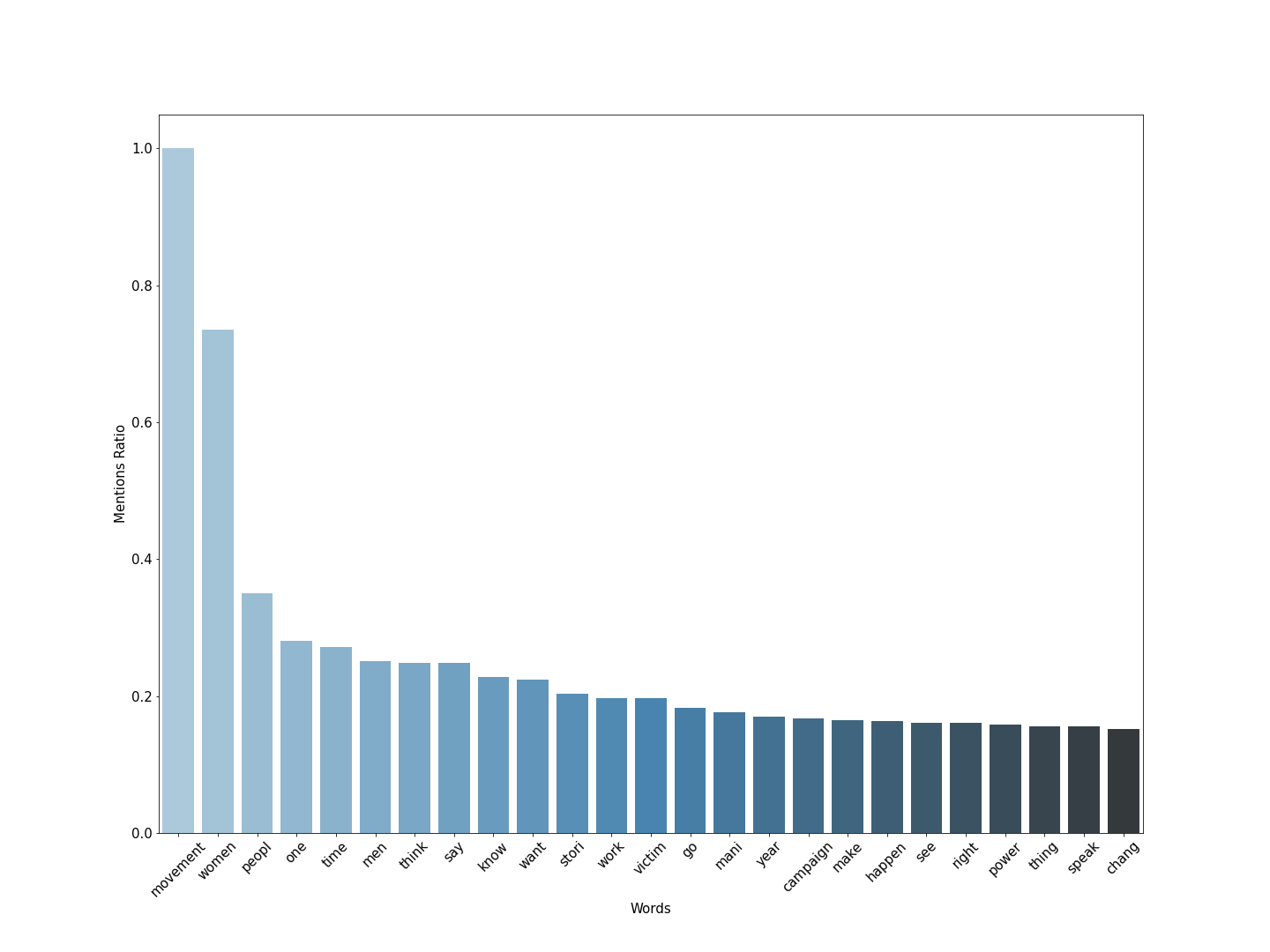
These are samples of the initially extracted quotes.
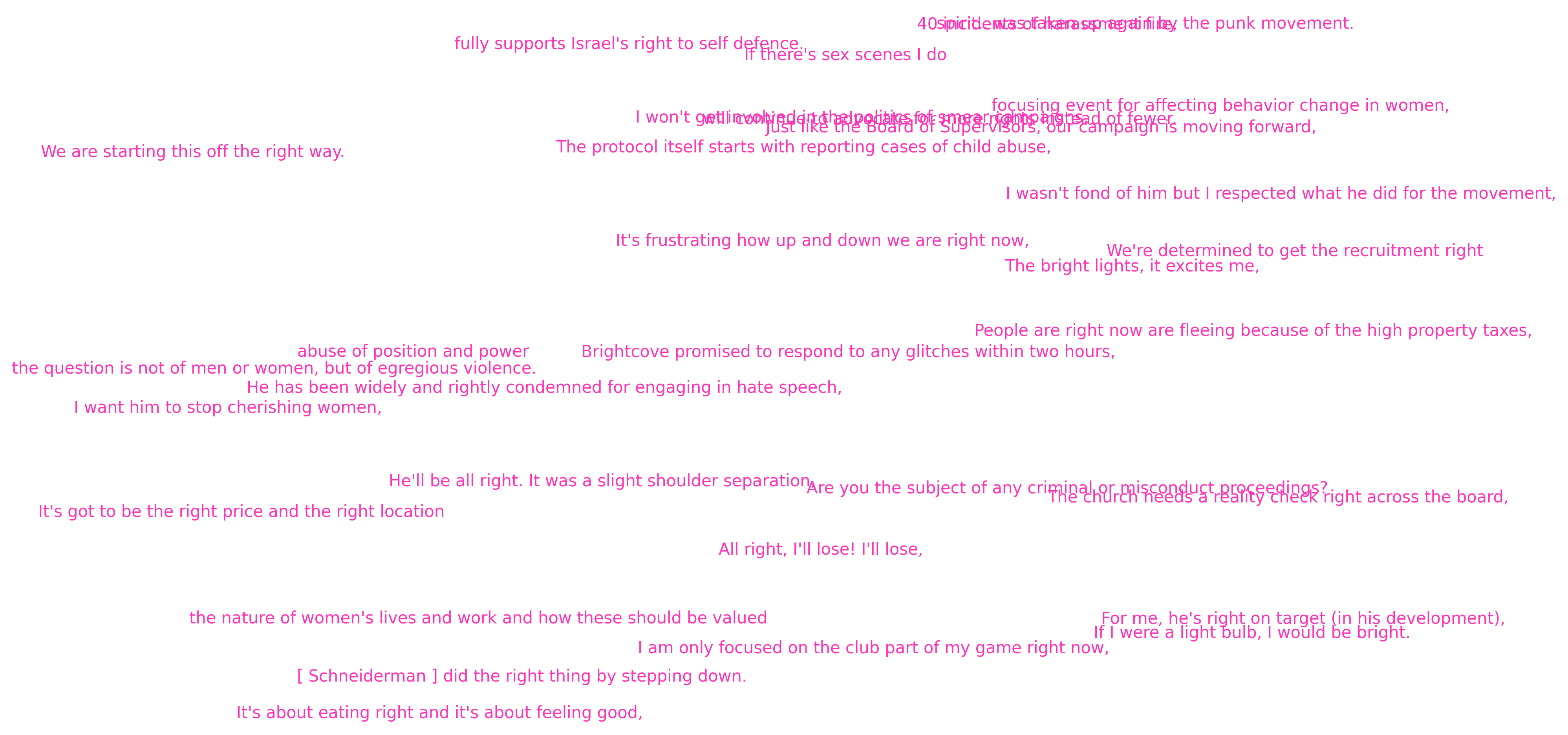
Some of them do not look quite right, as we included some general keywords in our selection. We set out to refine our sample: using Latent Dirichlet Allocation (LDA) we assigned a topic to each of the previously extracted quotes. The topics detected by the LDA were very insightful of the content of the quotes extracted so far.
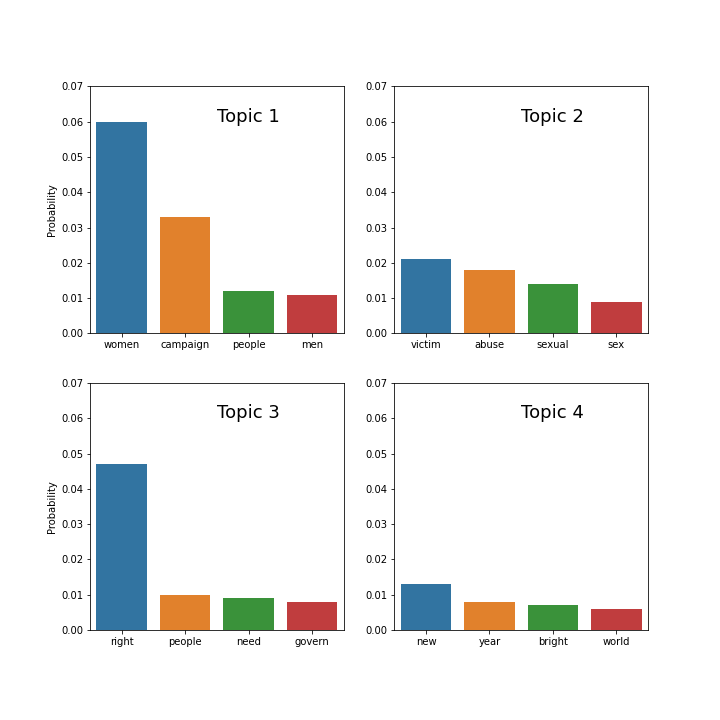
We could interpret these topics as:
- Women Empowerment 👩
- Sexual Harassment ❌
- Politics 📰
- Christmassy 🎄
The second topic seems to be more like our target. It was further investigated by adding another LDA layer to filter it more. Then, we applied a PCA to explore the clustering of the latest topics generated. The plot below shows a subsample of the first 2 PCA dimensions of the extracted quotes before filtering them based on the topics for a second time. (You can read the quote itself by hovering the data point on the plot!)
By labelling the quotes with the latest topics of the final LDA we could see the clusters of different topics that are overlapping.
The clusters could be interpreted as
- US Politics 🔥
- Sports ⚽
- Sexual Harassment ❌
- Global Politics 📰
By taking a closer look we notice that the quotes linked to the third topic, in green, do indeed refer to sexual harassment. Now that we have successfully isolated these quotes we can start our analysis!
(As a side note: notice how the outermost post at the top refers to a quote by Bill Clinton: “I did not have sexual relations with that page”, which was correctly labelled as a quote on politics and not sexual harassment even though the LDA algorithm did not have access to any information related to the speaker!)
The timeline of the counts of these quotes can be firstly observed on a monthly resolution to get an idea of the trends. It is evident that apart from a few early dips due to missing data the baseline increased significantly at the end of 2017, when the MeToo movement first became well known, sparking an increased conversation about sexual harassment. We can already see some sharp increases over the overall trend, which will be investigated further while examining events’ impacts.
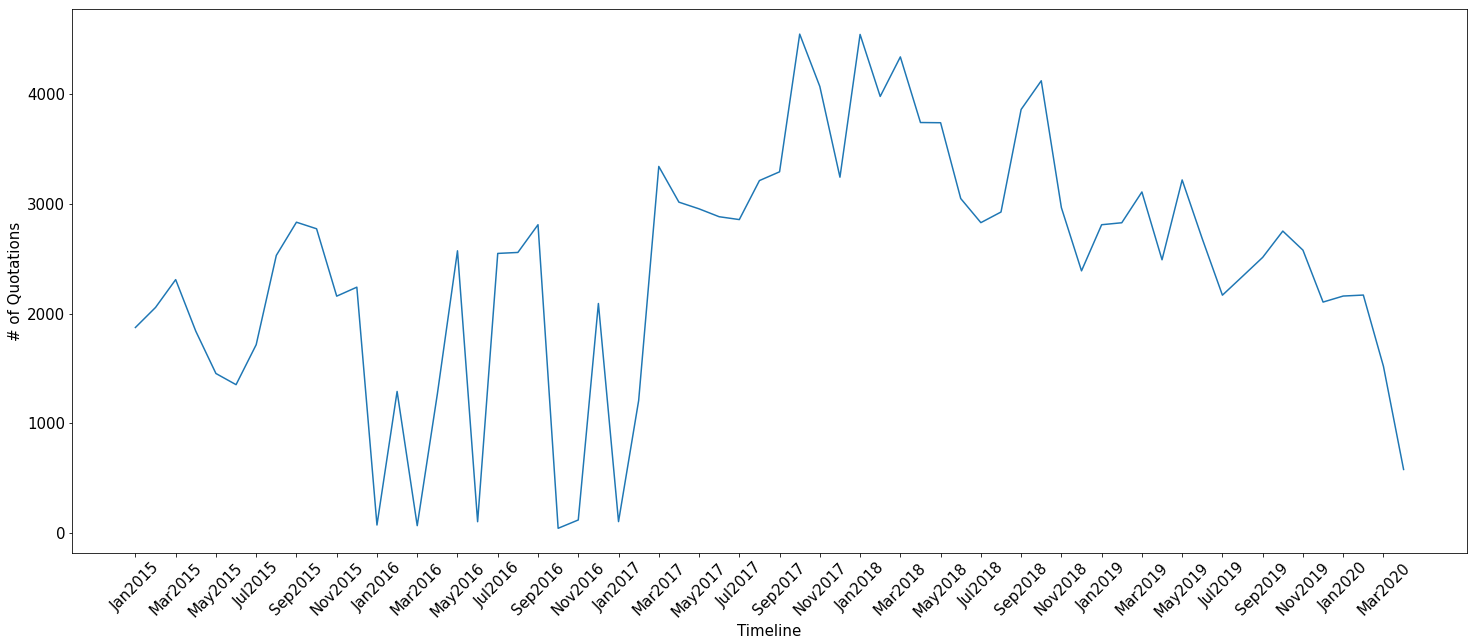
Which events are responsible for the growth of the MeToo movement ?
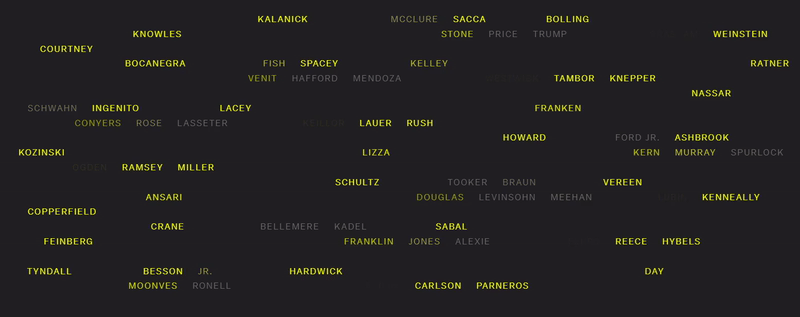 |
|---|
| Names of Celebrities, Politicians and CEOs accused of Sexual Misconduct |
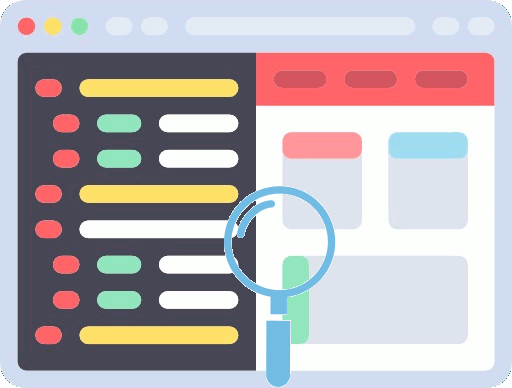 Over the years the #MeToo movement has been marked by a few key traumatic events which lead to a sharp increase in its popularity. We were interested in the impact of some events on the MeToo movement. In other words, whether trends in the #MeToo timeline were temporally linked to some events.
Thus, we gathered a dataset of traumatic events, itemising events related to the core issue of sexual harassment: the allegations by victims. The main source is a Vox article listing more than 250 public figures who were accused of sexual harassment between 2017 and 2019. Accordingly, we scraped this website to compile the needed data.
Over the years the #MeToo movement has been marked by a few key traumatic events which lead to a sharp increase in its popularity. We were interested in the impact of some events on the MeToo movement. In other words, whether trends in the #MeToo timeline were temporally linked to some events.
Thus, we gathered a dataset of traumatic events, itemising events related to the core issue of sexual harassment: the allegations by victims. The main source is a Vox article listing more than 250 public figures who were accused of sexual harassment between 2017 and 2019. Accordingly, we scraped this website to compile the needed data.
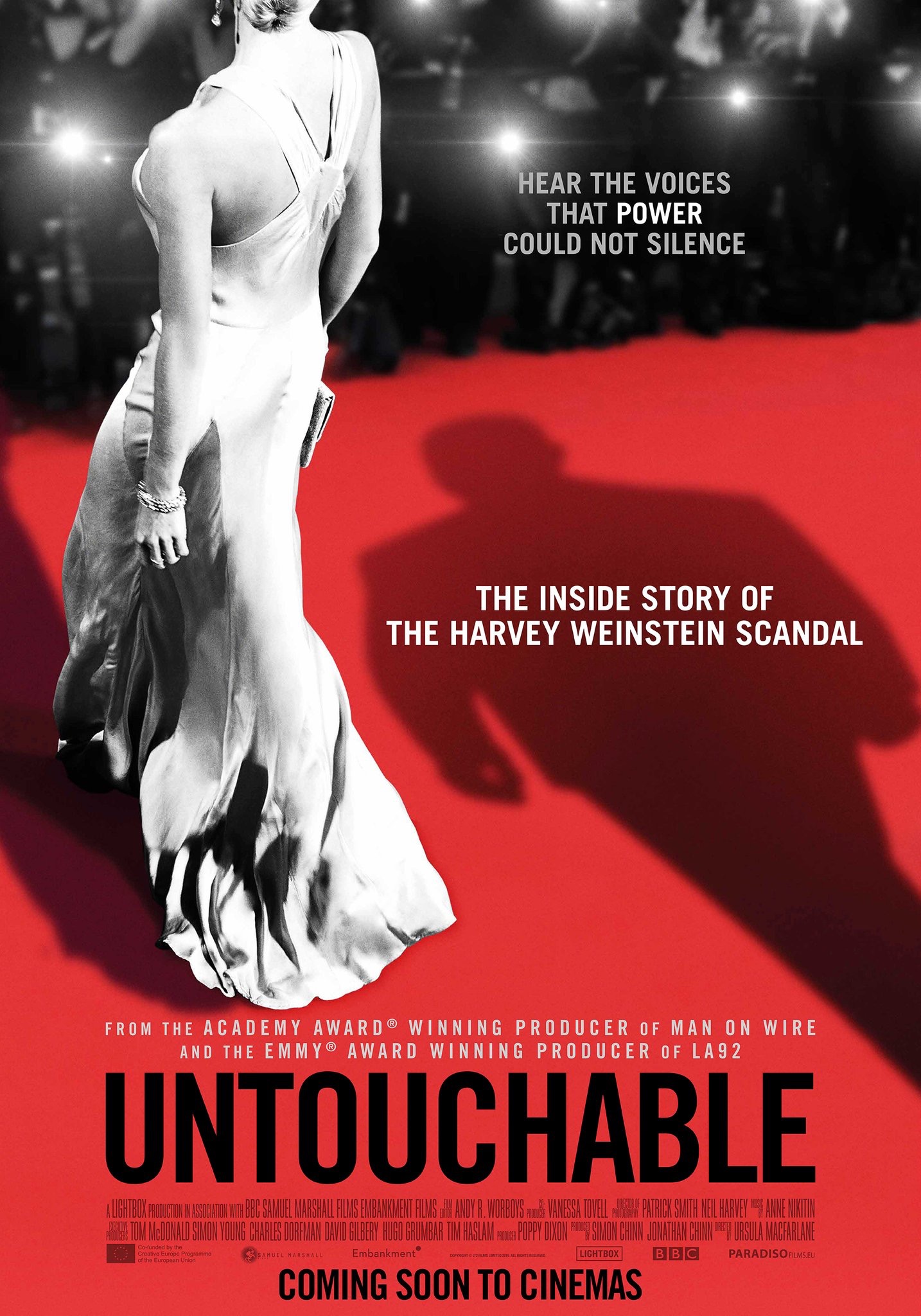 In parallel, we manually assembled a dataset of non-traumatic events found by original research. We chose events that are not related to the core issue of sexual harassment and consequences, such as movie releases, publications, demonstrations, and others related to MeToo in the same time period as above.
We assume the number of quotes related to MeToo each day to be a proxy of the attention to the topic.
In parallel, we manually assembled a dataset of non-traumatic events found by original research. We chose events that are not related to the core issue of sexual harassment and consequences, such as movie releases, publications, demonstrations, and others related to MeToo in the same time period as above.
We assume the number of quotes related to MeToo each day to be a proxy of the attention to the topic.
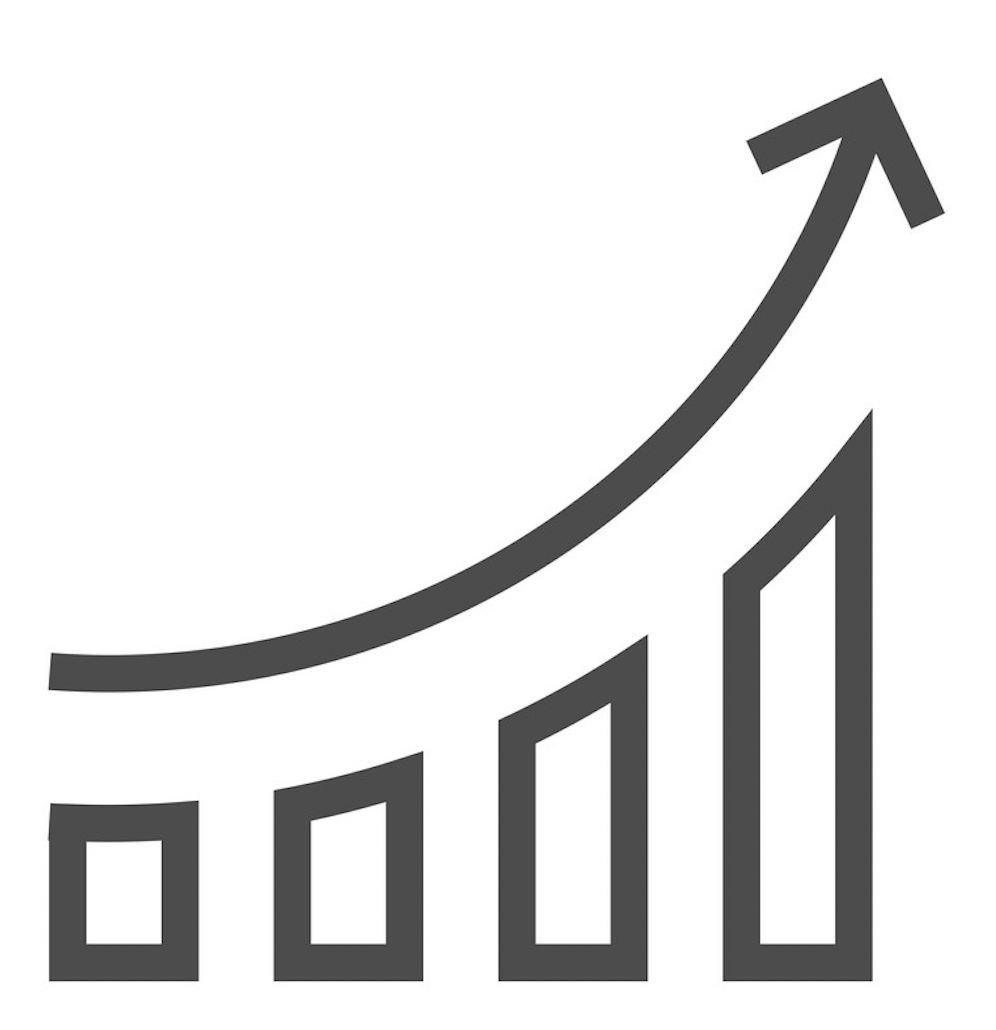 Quantify the impact: We plan to measure the impact of each event as the before-after difference in public attention and use this measure to investigate and compare traumatic vs non-traumatic events. This in practice is done by taking the average of the number of quotes 2 weeks before and after the date of the event to identify the trend to which the event belongs.
Quantify the impact: We plan to measure the impact of each event as the before-after difference in public attention and use this measure to investigate and compare traumatic vs non-traumatic events. This in practice is done by taking the average of the number of quotes 2 weeks before and after the date of the event to identify the trend to which the event belongs.
What is the impact of traumatic events ?
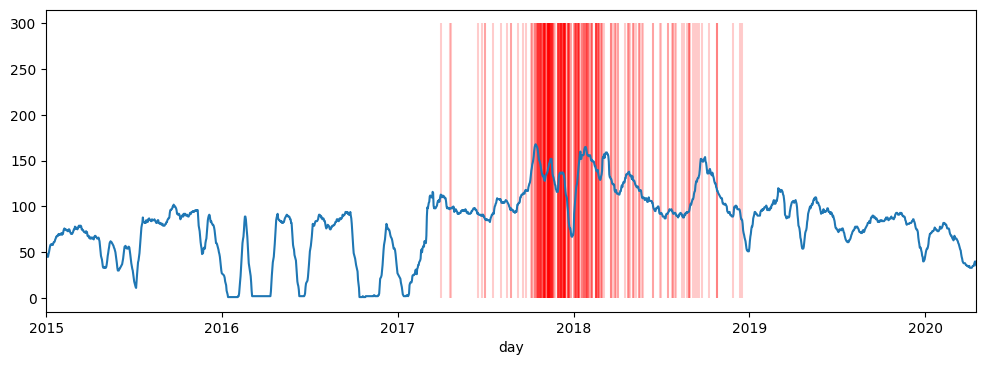 This plot displays the timeline of extracted quotes involved with the #MeToo movement and the timing of the allegations/accusations. We can already observe two huge waves of accusations in the middle of 2017 and early 2018.
This plot displays the timeline of extracted quotes involved with the #MeToo movement and the timing of the allegations/accusations. We can already observe two huge waves of accusations in the middle of 2017 and early 2018.
Now that we have our traumatic events we can measure their impact on the number of quotes related to sexual harassment.
| Distribution of traumatic events impacts | Top 10 most impactful events 💥 |
|---|---|
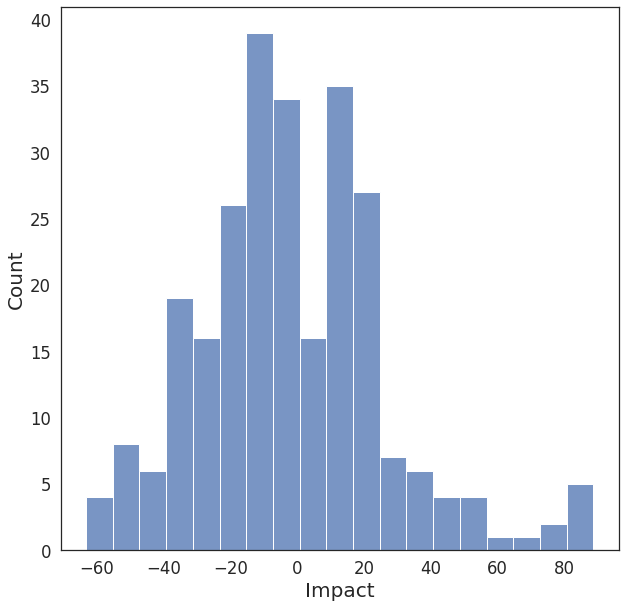 |
 |
When ranking the events based on impact we notice that the most impactful events belong to the 3 main waves of accusations, indicating that these waves of accusations are indeed related to an increase in quotes related to sexual harassment. (Dear reader, you can check who was accused at which moment directly on the timeline!)
Upon further investigation, we notice that the first wave in October 2017 corresponds to the moment in which the #MeToo went viral for the first time. Interstingly, the second wave is not only linked to events directly linked to MeToo but happened at the same time as the birth of many other social movements inspired by MeToo: #SilenceIsNotSpiritual, MeTooK12 and the discussion of the ME TOO bill in U.S. Congress. As for the third wave it corresponds to the accusation of Brett Kavanaugh.
What is the impact of non-traumatic events ?
Now let’s take a look at the non-traumatic events!
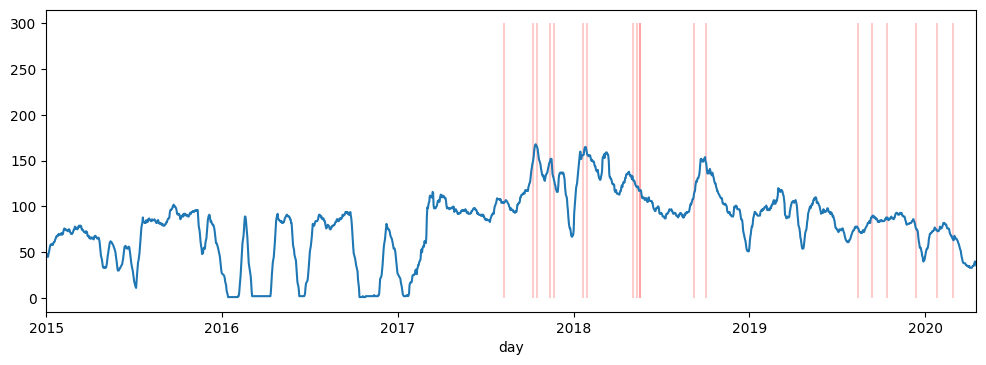
This plot displays the timeline of #MeToo quotes and the top 10 most impactful non-traumatic events.
It is evident that our impact measure detected two main waves in the public attention. The first which rises above the baseline is in October 2017, which is the moment in which the hashtag went viral for the first time
After a dip during Christmas due to the reduction of people releasing quotes, we can witness another large wave in January 2018.
| Distribution of non-traumatic events impacts | Top 10 most impactful events 💥 |
|---|---|
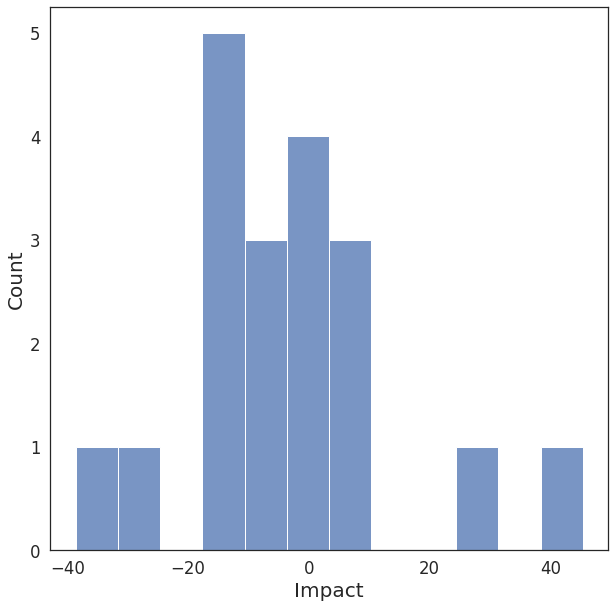 |
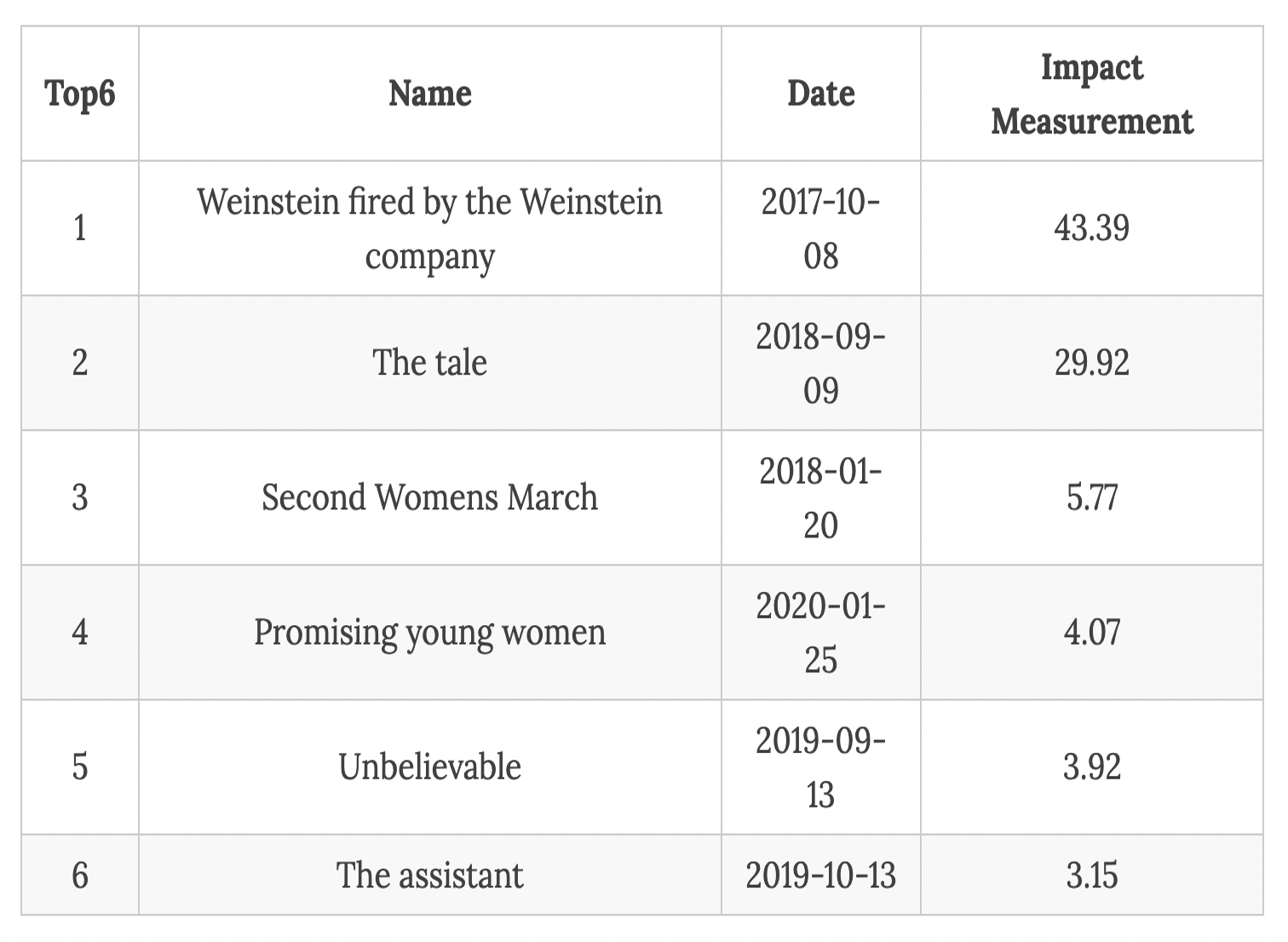 |
How does the impact of non-traumatic and traumatic events compare ?
The impact measure we obtained is higher for the traumatic events before the aforementioned waves. It appears then that the movement was fueled by clusters of accusations. These probably also influenced one another by providing motivation to come forward to the victims. Non-traumatic events are more scattered and therefore had less impact on the timeline we analysed. In addition, some non-traumatic events can be considered consequences of traumatic events. One good example is the firing of Harvey Weinstein, which is the most impactful out of the non-traumatics.
If you have paid attention to the beginning of this post you might remember the movie *Bombshell, which we mentioned as an example of a non-traumatic event acting as a catalyst, however, it does not appear to have had a big impact on the number of quotes. Although this might just indicate its impact was not as big as we anticipated, we rather believe that it is due to the release of the movie being in December. Indeed we notice that each year there is a sharp decrease in the amount of quotes observed in December, which might have hidden the impact of Bombshell.
How does the tweet dataset confirm our results?
The tweets dataset related to MeToo were processed in a similar way to obtain a timeline. Unfortunately the time covered ranges only from October 2018 to February 2019. We therefore restricted our analysis to the events around this time period.
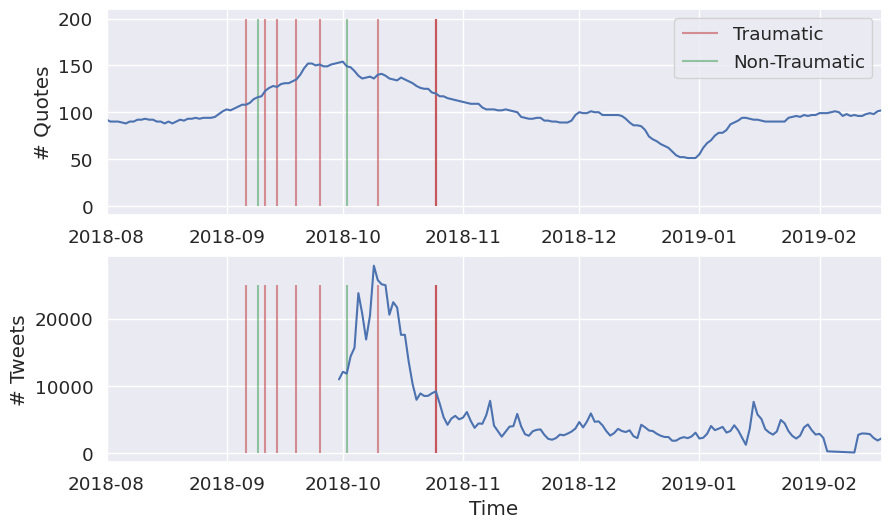
None of the events analysed seems to directly impact the subsequent wave: by closely examining them one stands out. It is widely believed (Darwish, 2019) that the revival of #MeToo in September and October 2018 was due to the accusations levelled towards Brett Kavanaugh, made public on Sep. 16, which sparked an FBI investigation after widely covered hearings with the judiciary committee. On October 6th Kavanagh would go on to be confirmed by the senate in a polarized debate. The entire story lasted for weeks, becoming the main topic in the news and the subsequent online conversation on #MeToo would then peak and slowly return to baseline levels.
Darwish, K. (2019). Quantifying Polarization on Twitter: The Kavanaugh Nomination. ArXiv, abs/2001.02125.
Here, we assembled a random sample of tweets and visualized the location of these tweets on an interactive map to explore their distribution.
Is there a gender bias in the speakers of quotes related to sexual harassment?
Given the inherently gendered nature of sexual harassment, we were interested in the gender ratio of the quoted people in Quotebank 2015-2020 and in the dataset of #MeToo quotes. We hypothesised, due to the gender gap in leadership positions in many public fields, that there would be more quotes from males than females (and others) in Quotebank, and we wondered whether this feature would remain in the #MeToo quotes dataset we isolated.
| Distribution in Quotebank [6M quotes] | Distribution in #MeToo [200k quotes] |
|---|---|
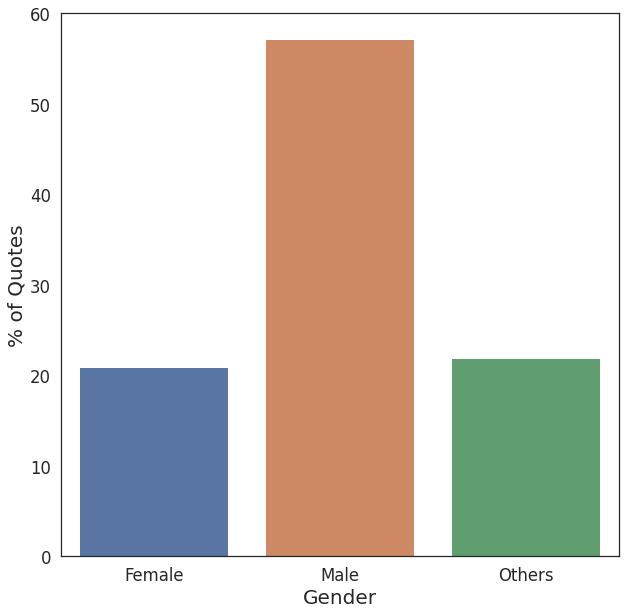 |
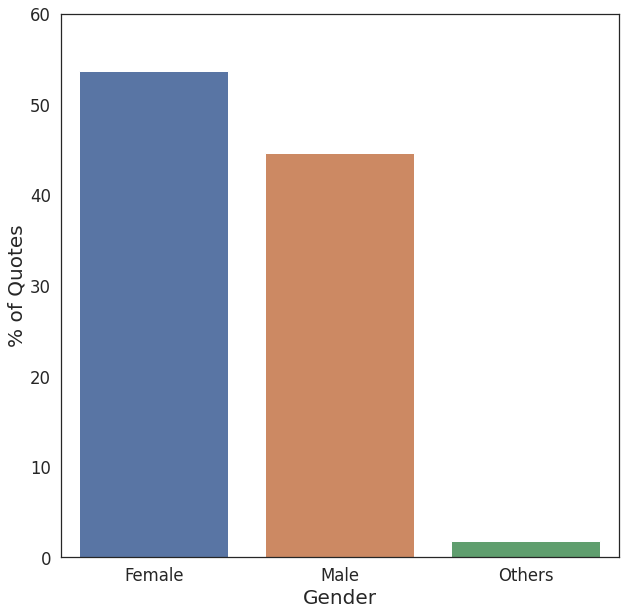 |
We can observe that there is indeed a gender bias in the Quotebank dataset. It is also clear that this ratio is reversed when dealing with the filtered data, which highlights how women have been the driving force behind the #MeToo rise. This fact even lead to the creation of a countermovement, #HimToo, a hashtag originally focused on harassment on men but then redirected towards the apparent ease with which men could suffer negative consequences after being falsely accused (Boyle, Rathnayake, 2019). The time required for the legal process to actually settle the truth of accusations is most of the time too long and the career of the accused men, even if acquitted, can suffer. The Quotebank dataset gave us the means to find out how people were silenced, or cancelled, after an accusation.
Boyle, K. and Rathnayake, C., 2019. #HimToo and the networking of misogyny in the age of #MeToo. Feminist Media Studies, 20(8), pp.1259-1277.
Can we observe cancel culture as a ramification of the #MeToo movement?
With more than 2.4 million posts under the “#MeToo” hashtag on Instagram in 2020, the movement has a very prominent position in the media (Instagram, 2020). Whilst the movements prevalence in media promotes a supporting and positive environment for individuals or victims who choose to come out with their sexual violence stories, this reflection discusses how the #MeToo movement has inadvertently encouraged toxicity on social media in the form of cancel culture. This toxic public discourse, cancel culture, is shown in prominent cases in media such as the example of Johnny Depp versus Amber Heard sexual and domestic violence allegations (ABC News, 2019). In which Johnny Depp was accused of sexual and domestic violence in 2016, resulting in him being “cancelled”. This included being dropped from his role in the Pirates of the Caribbean. We wanted to investigate this phenomenon using the Quotebank dataset.
We took three examples of convicted people in the last five years present in the quotes or as speakers in the Quotebank dataset :
Al Franken : American comedian, politician, media personality, who served as a Senator from Minnesota from 2009 to 2018, resigned on January 2, 2018, after several allegations of sexual misconduct were made against him.
| Al Franken | Quotes He spoke | Quotes mentioning him |
|---|---|---|
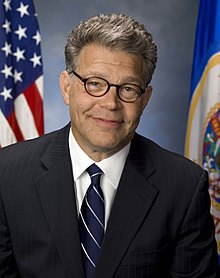 |
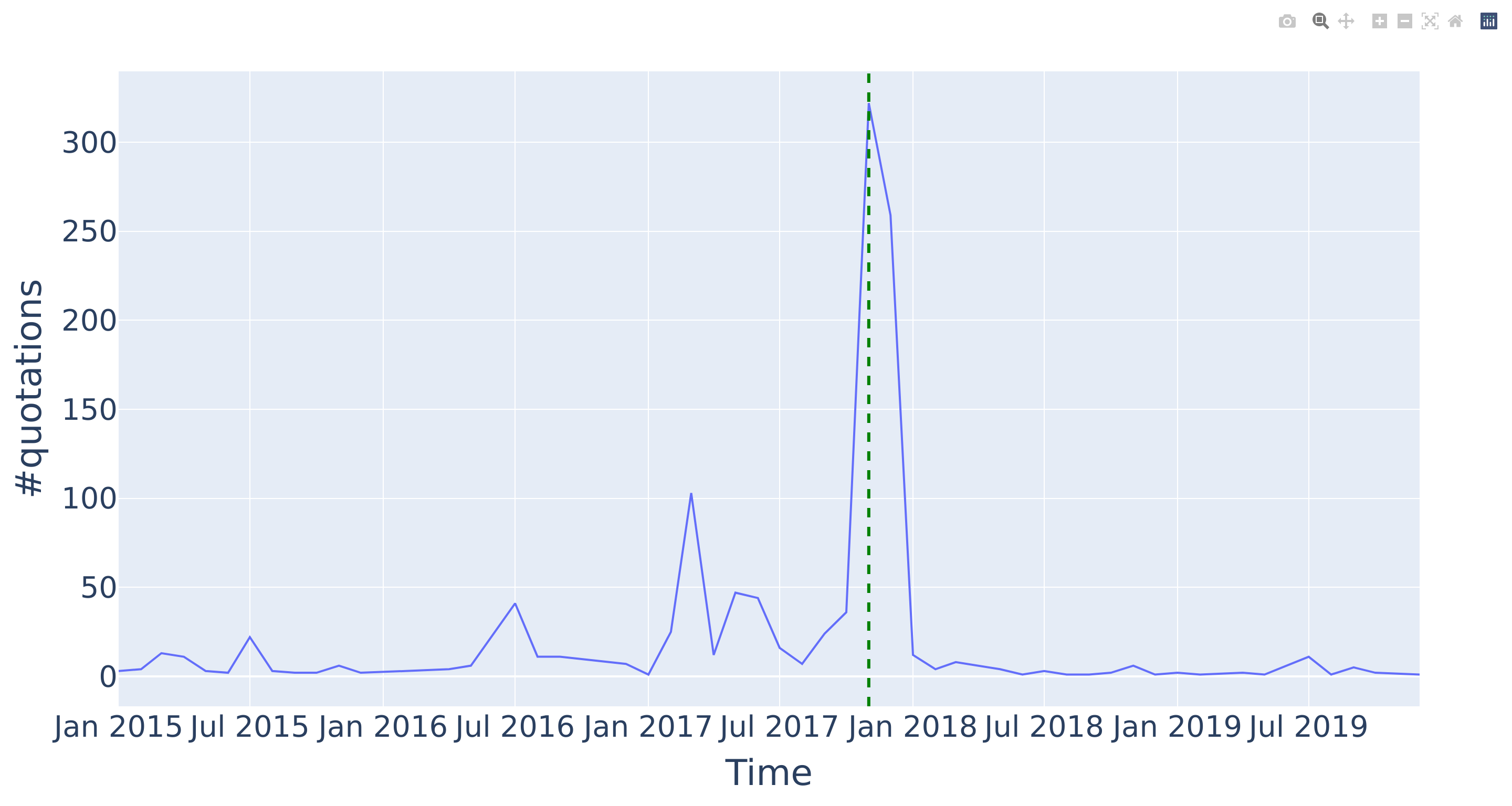 |
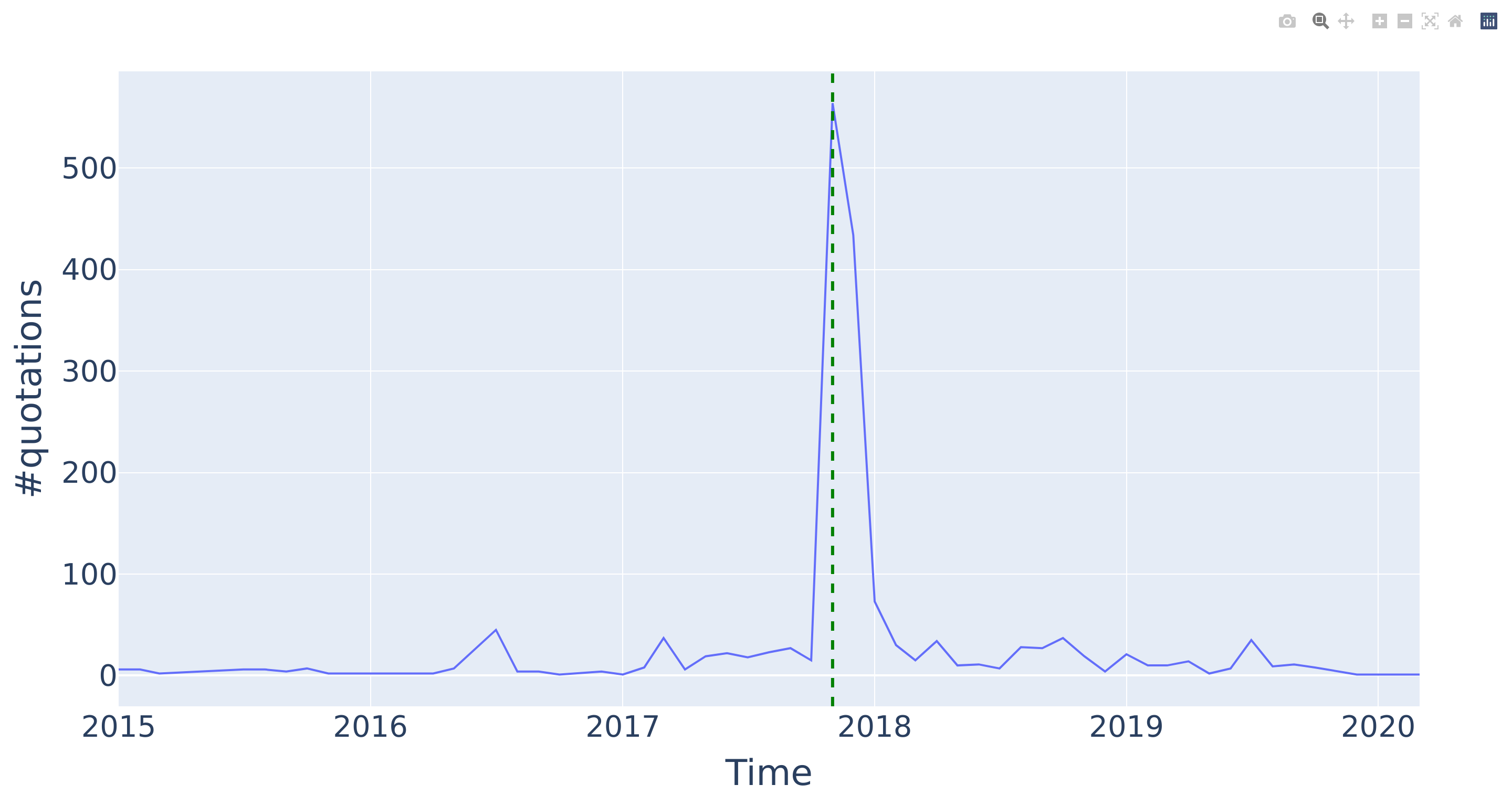 |
Eric Schneiderman : American lawyer and politician who served as the 65th Attorney General of New York from 2011 until his resignation in May 2018 after The New Yorker reported that four women had accused him of physical abuse.
| Eric Schneiderman | Quotes He spoke | Quotes mentioning him |
|---|---|---|
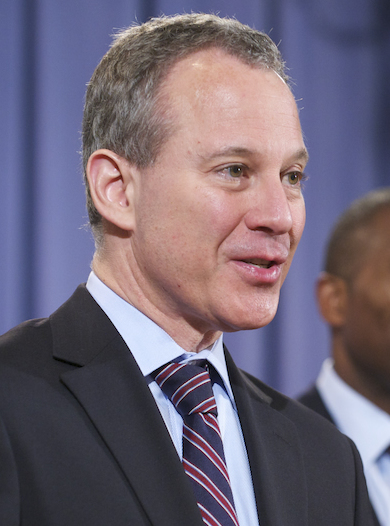 |
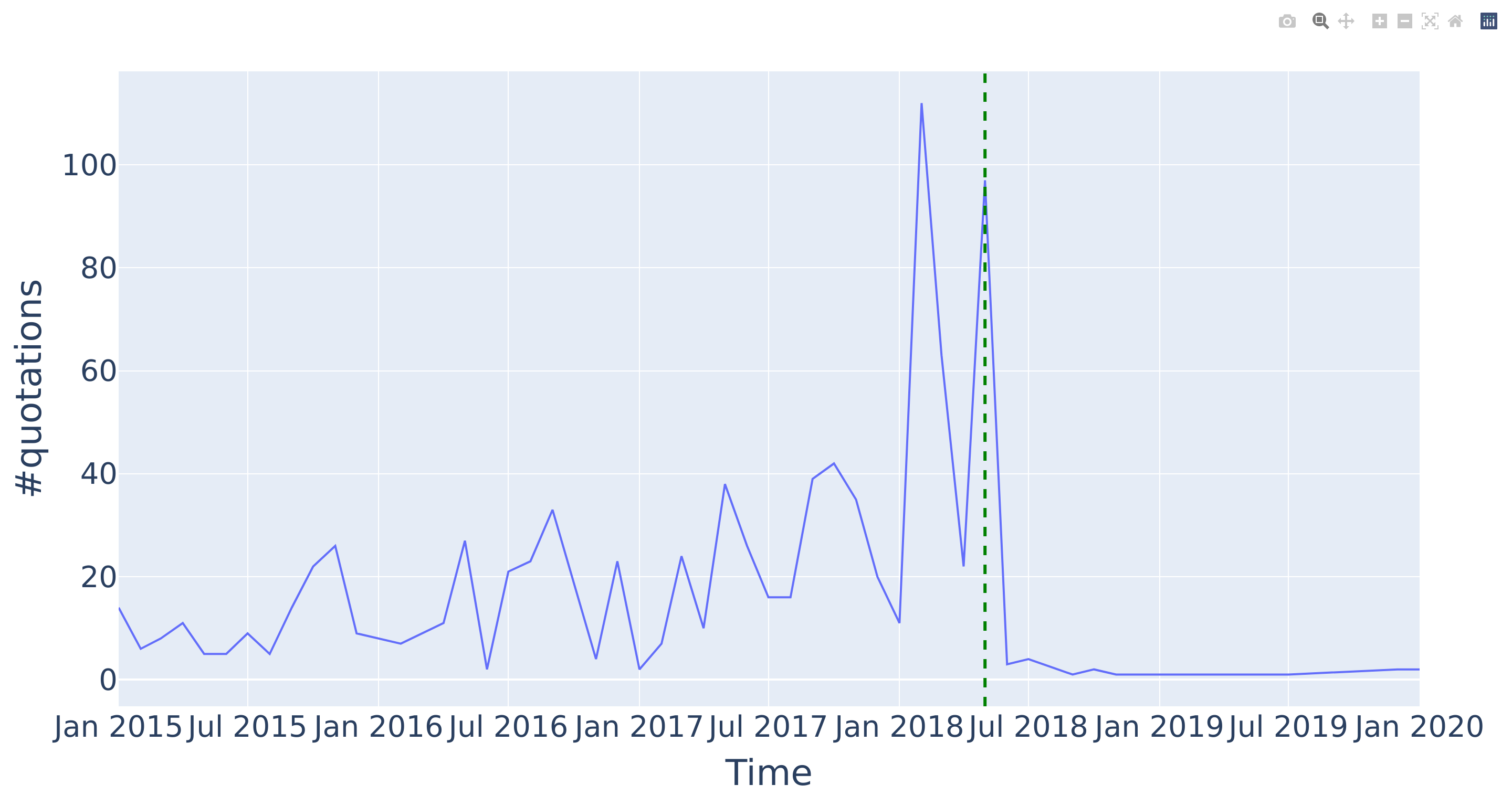 |
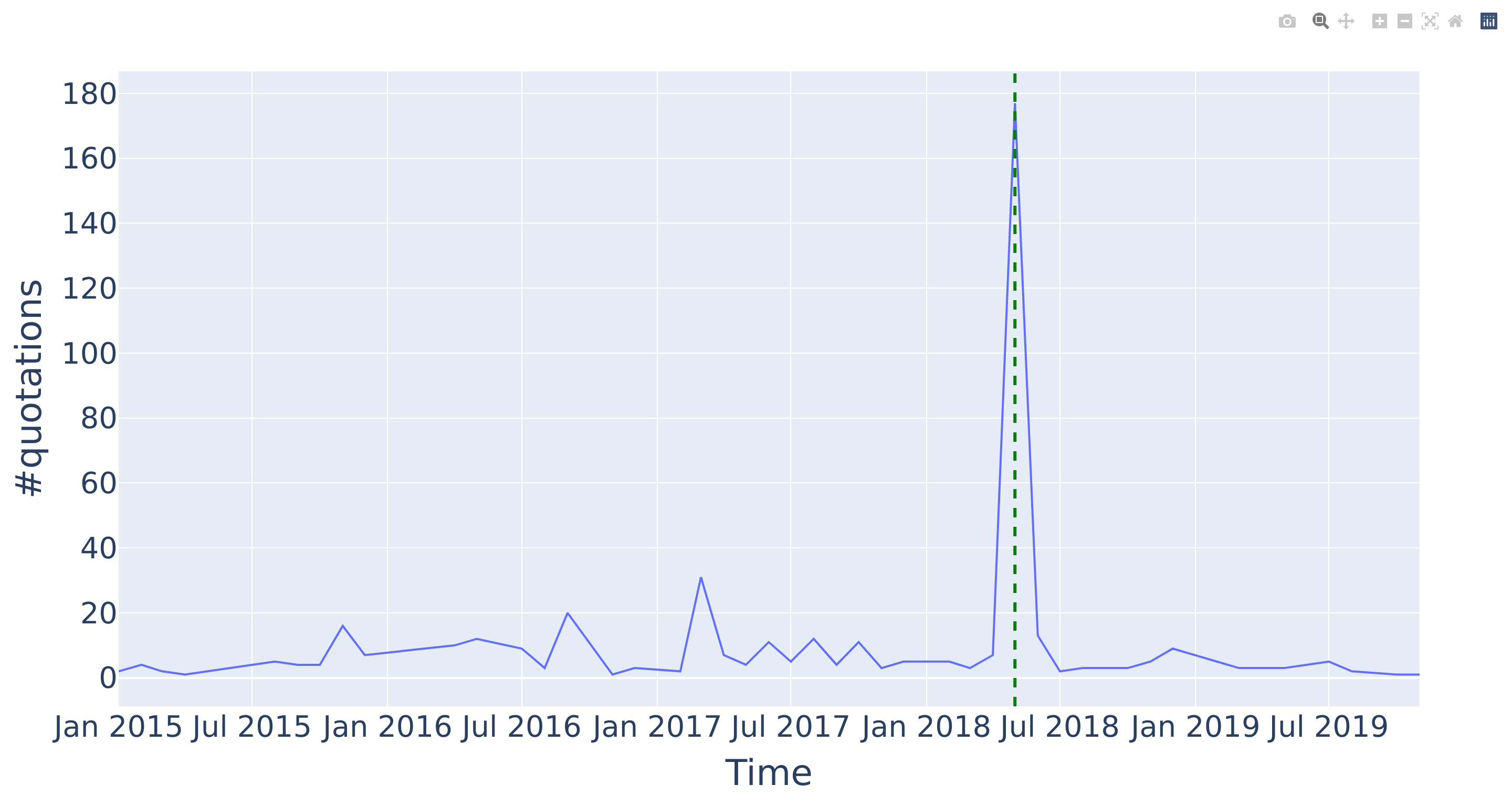 |
Andrew Kreisberg : American television writer, producer and comic book writer. Kreisberg was suspended on November 10 in 2017, from his role as showrunner on The Flash, Arrow, Legends of Tomorrow, and Supergirl, after fifteen women and four men accused him of sexual harassment. On November 29, 2017, he was fired from all of Warner Bros. Television’s projects.
| Andrew Kreisberg | Quotes He spoke | Quotes mentioning him |
|---|---|---|
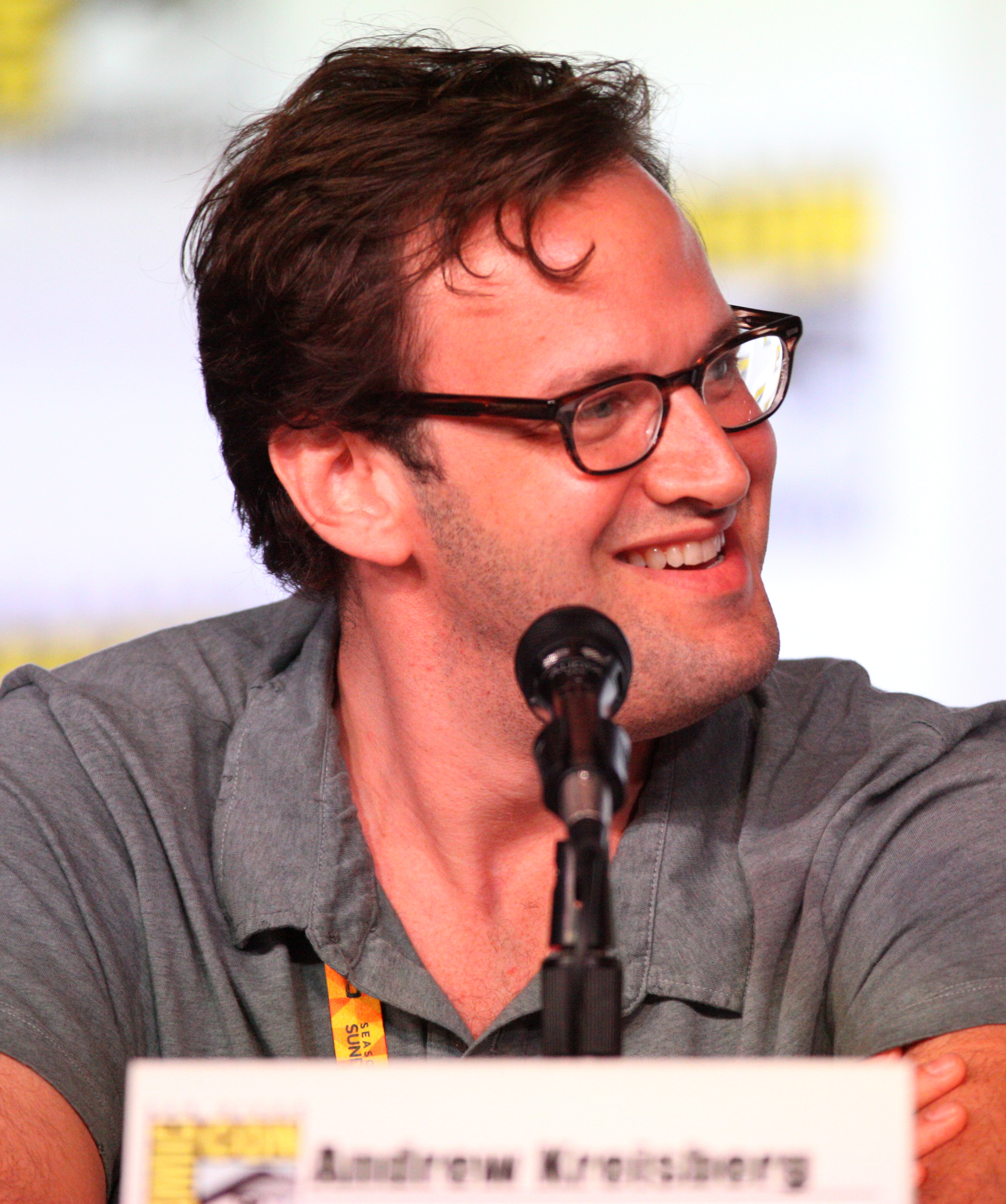 |
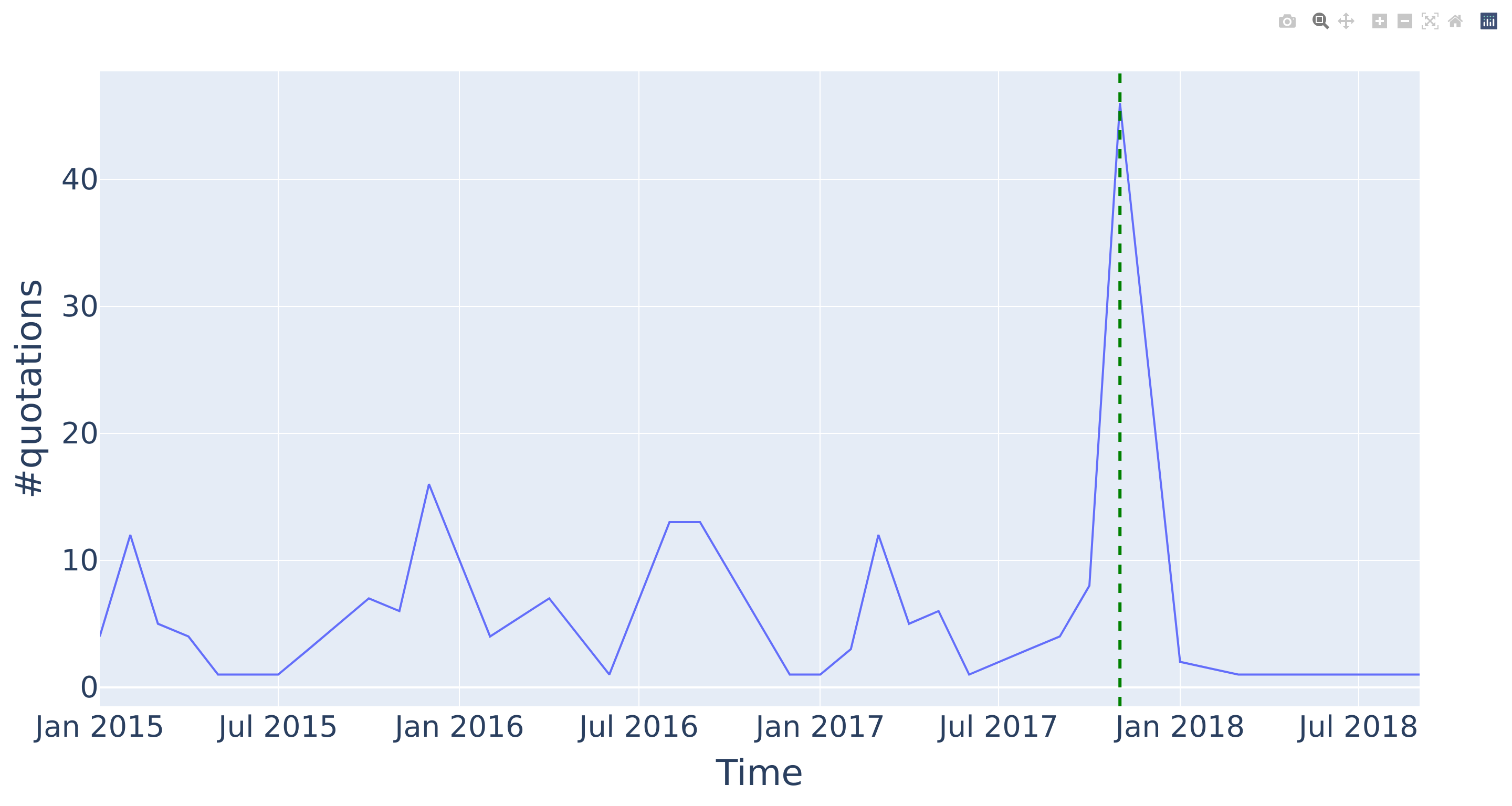 |
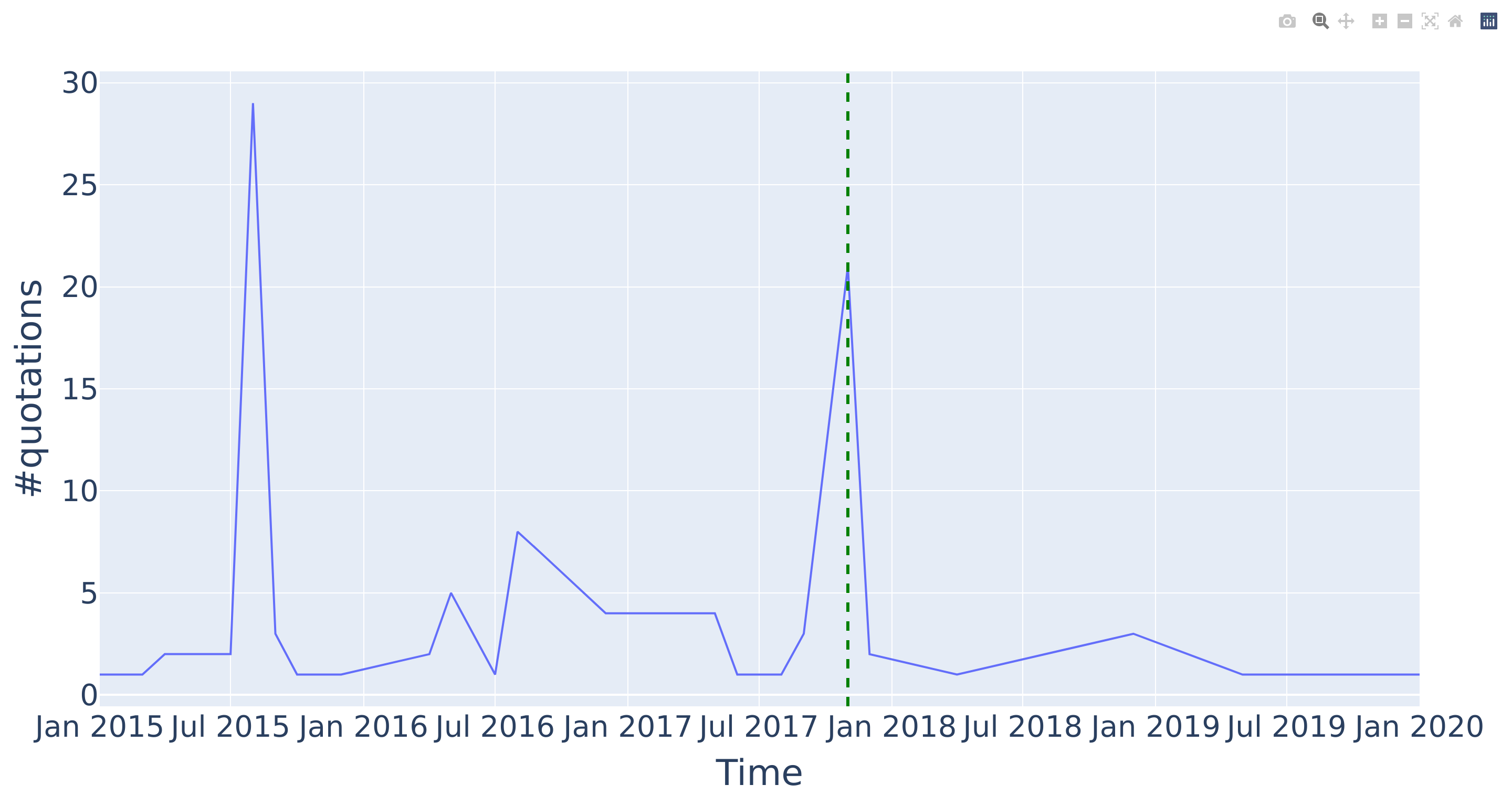 |
We can observe that the three examples seems have been cancelled by the media as the number of quotes spoken by them and the number of quotes mentioning them drastically decreased right after their conviction.
Statistical analysis
This observation has still to be confirmed by statistical analysis using a t-test assessing the difference of means of the number of quotes between the periods before and after their conviction. This has been done while studying a set of 65 accused people, mostly Americans.
First, a t-test has been assessed between the normalized means of the count of quotes pronounced by them between the periods before and after their conviction, for each of the 65 accused people. This resulted with a significant p-value (p = 0.00046 <0.05). This showcases that accused people are probably rejected by the society, giving them less time to express themselves, shutting them off the media, radios. Secondly, another t-test has been assessed between the normalized means of the count of quotes mentioning them, again between the periods before and after their conviction, for these same 65 accused people. This resulted with a non-significant p-value (p = 0.672 > 0.05). This means that we couldn’t show that society, in general, talks less about these people after their conviction.
Conclusion
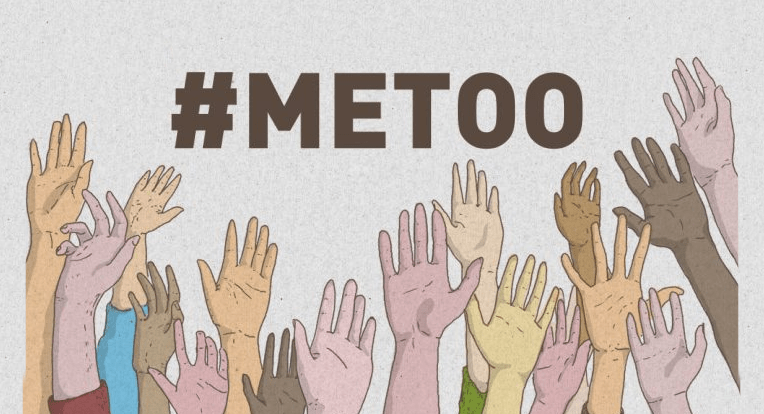 Based on the analyses performed, the ebb and flow of media coverage and therefore public attention on MeToo and sexual harassment can be directly linked to a few traumatic events, i.e. accusations, that happened in waves. Only some very famous people being accused in a short time frame helped shape media coverage. These in turn promoted the existence of non-traumatic events, such as manifestations and documentaries.
In conclusion, further research in addition to this analysis, scraping all newspapers’ websites, social media interactions etc. to get a much deeper understanding of the main factors affecting a human rights movement would be more than warranted. Nonetheless, the Quotebank dataset is a powerful proxy of public discussion: it is uniquely suited to analyse for example how much people are able to reach the wider public or not, as we did with cancel culture.
Based on the analyses performed, the ebb and flow of media coverage and therefore public attention on MeToo and sexual harassment can be directly linked to a few traumatic events, i.e. accusations, that happened in waves. Only some very famous people being accused in a short time frame helped shape media coverage. These in turn promoted the existence of non-traumatic events, such as manifestations and documentaries.
In conclusion, further research in addition to this analysis, scraping all newspapers’ websites, social media interactions etc. to get a much deeper understanding of the main factors affecting a human rights movement would be more than warranted. Nonetheless, the Quotebank dataset is a powerful proxy of public discussion: it is uniquely suited to analyse for example how much people are able to reach the wider public or not, as we did with cancel culture.
.gif)